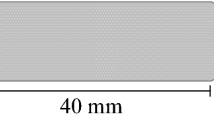Abstract
Invading track of chloride ions and chloride ion distribution rule in cement-based materials were investigated by partially soaking in 3.5% (mass fraction) NaCl solution and fully immerging in 3.5% and 5.0% (mass fraction) NaCl solution, respectively, and relevant invading mechanisms were discussed. Results indicate that under full immerging condition, the invading track of chloride ions in cement mortar is similar to beeline that is vertical to chloride ion invading direction, and chloride ion content decreases rapidly with the increase of chloride ion invading depth. Under partial soaking condition, the invading track of chloride ion in cement mortar is similar to the shape of concave parabola, and chloride ion content decreases slowly along the lengthway direction of cement mortar samples in the distance of 20–80 mm from the bottom. Lots of chloride ions accumulate in cement mortar surface layer under the effect of capillary rise and evaporation and then invade cement mortar by diffusion effect. Under partial soaking condition, cement mortar is distinguished by four areas, i.e., immerging area, wet area, crystallization area and dry area.
Similar content being viewed by others
References
JENSEN O M, HANSEN P F, COATS A M, GLASSER F P. Chloride ingress in cement paste and mortar [J]. Cement and Concrete Research, 1999, 29(9): 1479–1504.
MECK E, SIRIVIVATNANON V. Field indicator of chloride penetration depth [J]. Cement and Concrete Research, 2003, 33(8): 1113–1117.
HOSSAIN K M A, EASA S M, LACHEMI M. Evaluation of the effect of marine salts on urban built infrastructure [J]. Building and Environment, 2009, 44(4): 713–722.
LIANG M T, LAN J J. Reliability analysis for the existing reinforced concrete pile corrosion of bridge substructure [J]. Cement and Concrete Research, 2005, 35(3): 540–550.
YU H, HARTT W H. Effects of reinforcement and coarse aggregates on chloride ingress into concrete and time-to-corrosion. Part 1: Spatial chloride distribution and implications [J]. Corrosion, 2007, 63(9): 843–849.
LONG Guang-cheng, XING Feng, YU Zhi-wu, XIE You-jun. Precipitation characteristics of SO4 2− ion and Cl− ion in mortars under natural diffusion condition [J]. Journal of Materials Science and Engineering, 2008, 26(5): 679–683. (in Chinese)
SHI Hui-sheng, WANG Qiong. Research on the factors influencing on the chloride ingression in cement-based material [J]. J Build Mater, 2004, 7(3): 256–290. (in Chinese)
YU Hong-fa, SUN Wei, MA Hai-yan. Diffusion equations of chloride ion in cement-based material under the combined action of durability factors [J]. J Build Mater, 2002, 5(3): 240–247. (in Chinese)
YANG C C. On the relationship between pore structure and chloride diffusivity from accelerated chloride migration test in cement-based materials [J]. Cement and Concrete Research, 2006, 36(7): 1304–1311.
CASTELLOTE M, ANDRADE C, ALONSO C. Measurement of the steady and non-steady-state chloride diffusion coefficients in a migration test by means of monitoring the conductivity in the anolyte chamber comparison with natural diffusion tests [J]. Cement and Concrete Research, 2001, 31(10): 1411–1420.
YANG C C, CHO S W, HUANG R. The relationship between charge passed and the chloride-ion concentration in concrete using steady-state chloride migration test [J]. Cement and Concrete Research, 2002, 32(2): 217–222.
GEORGE W S. Stress from crystallization of salt [J]. Cement and Concrete Research, 2004, 34(9): 1613–1624.
NIELSEN E P, GEIKER M R. Chloride diffusion in partiallysaturated cementitious material [J]. Cement and Cement Research, 2003, 33(1): 133–138.
ZHANG T W, GJRV ODD E. Effect of chloride source concentration on chloride diffusivity in concrete [J]. ACI Materials Journal, 2005, 102(5): 295–298.
MA Kun-lin, XIE You-jun, LONG Guang-cheng. Deterioration characteristic of cement mortar by physical attack [J]. J Chin Ceram Soc, 2007, 35(10): 1376–1381. (in Chinese)
WINKLER E M. Stone in architecture: Properties, durability [M]. Berlin: Springer-Verlag, 1994: 163–165.
MA Xiao-xuan, QIU Xian-gang, CHEN Cong-xing. Data accumulation and research on corrosion regularity for cement-based material and reinforced cement-based material in soil [J]. Build Sci, 1998, 14(1): 7–13. (in Chinese)
Author information
Authors and Affiliations
Corresponding author
Additional information
Foundation item: Project(50678174) supported by the National Natural Science Foundation of China
Rights and permissions
About this article
Cite this article
Ma, Kl., Xie, Yj., Long, Gc. et al. Invading track of chloride ions in cemented-based materials. J. Cent. South Univ. Technol. 17, 263–268 (2010). https://doi.org/10.1007/s11771-010-0040-4
Received:
Accepted:
Published:
Issue Date:
DOI: https://doi.org/10.1007/s11771-010-0040-4



